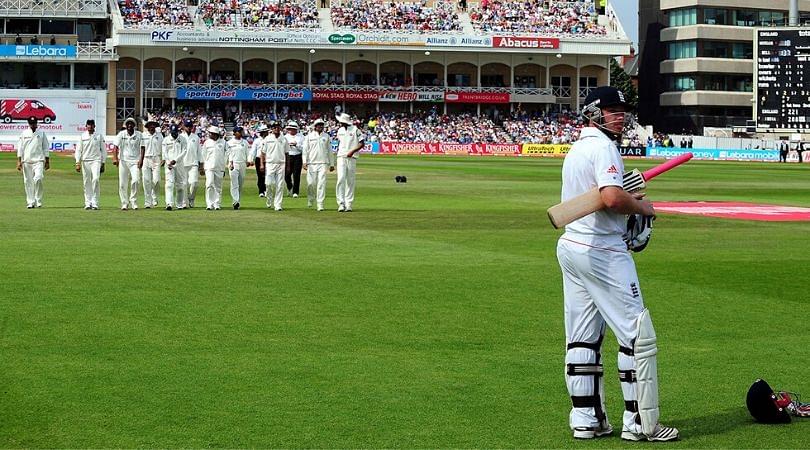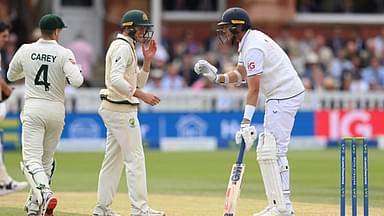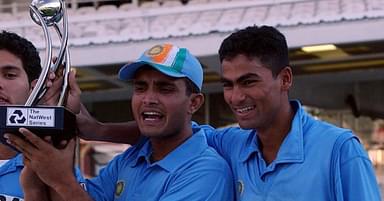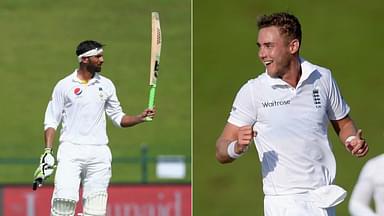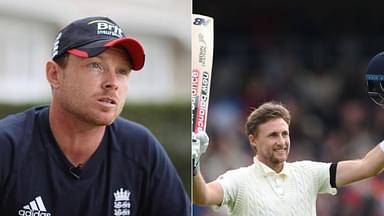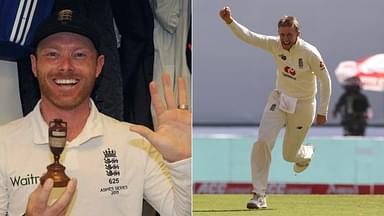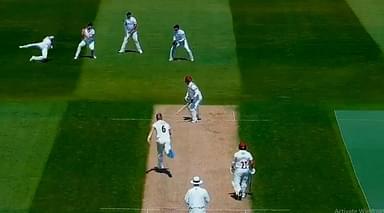Ian Bell run-out controversy vs India: The English batsman became victim of confusion alongside batsman Eoin Morgan in Nottingham.
Advertisement
During India’s tour of England in 2011, the visitors had lost the first test match at Lord’s, London, by 196 runs. Mahendra Singh Dhoni, the then India captain had won the toss and put England in to bat in the second match at Trent Bridge, Nottingham.
The Indian trio of fast bowlers in Praveen Kumar, Ishant Sharma and Sreesanth picking three wickets apiece saw England getting dismissed on 221 in 68.4 overs in the first innings. On the back of veteran batsman Rahul Dravid’s 34th Test century, India scored 288/10 in reply.
It was during the third day of this test when the infamous ‘Ian Bell run-out controversy’ took place. Promoted up the order as a replacement for injured Jonathan Trott, Bell came out to bat at No. 3. Having registered scores of 45, 0 and 31 in the series, Bell dominated the Indian bowlers on his way to his third Test century.
Ian Bell run-out controversy vs India
In what was the last ball before tea, England batsman Eoin Morgan tucked an Ishant Sharma on to the leg side. Running square from fine leg, Praveen Kumar put in a middle-of-the-road dive to stop the ball from going past the boundary rope.
Bell and Morgan were of the opinion that the ball had touched the rope and started to walk back to the pavilion at the conclusion of a session. Just then, Kumar threw the ball back to Dhoni who passed it to Abhinav Mukund as he dislodged the bails.
The Indians, well within their right, appealed for the dismissal. The replays showed that the ball did not cross the boundary rope. The verdict ruled Bell out on 137 as the ball was still alive. The batsmen, primarily Bell, assumed that the umpire Asad Rauf had called “over”. With Rauf handing back Sharma’s jumper after the bails were dislodged, whether he had called over or not remained the big question.
One man who was certainly not happy with the decision was Bell and it was clear from his reactions as he walked back to the pavilion. In an interview at the end of the day, he was quoted saying “I think the umpire took the jumper out of his [waist], just behind his back and started to walk over to the bowler and all just looked like it was going straight towards tea”.
There were speculations during the break that Dhoni would withdraw the appeal and recall Bell, who was again well within his right. However, why would a captain recall a well-set batsman? That too, when the lead was already of 214 runs for the batting side.
According to section 8 of Law 27 of cricket, “The captain of the fielding side may withdraw an appeal only if he obtains the consent of the umpire within whose jurisdiction the appeal falls. He must do so before the outgoing batsman has left the field of play”. Having said that, Bell had left the field in this case because it was time for tea.
Technically speaking, Bell was out. There was not an inch of doubt about it. The rules of the game do not allow the batsman to wander around while the ball is not dead. But there was one aspect, which had scope for Bell to return, and it was the “Spirit of the game’.
Despite this spirit being subjective, whatever happened was somewhere not correct as the batsmen had thought for the ball to have crossed the boundary. Not that the Indians were wrong or Bell was right, the whole situation was such that there was a pinch of unjust in it.
The tea break had witnessed England captain Andrew Strauss and coach Andy Flower meeting Dhoni and India coach Duncan Fletcher. The topic of discussion was understood. Dhoni and the whole team had made a decision that withdrawing the appeal was the way to go for the greater good of the game.
When the Indian players made their way out of the dressing room, angry English fans booed at them for whatever had happened before the break. And just when Bell walked out with Morgan, the boos were converted to a loud cheer. Even English cricketers were seen applauding from the balcony. Most of the former cricketers were of the opinion that Bell made an error but were at peace with whatever happened at the end.
“From Praveen’s [Kumar] body language, it looked like that had gone for four. Probably naive on my behalf, but taking into account the spirit of cricket and everything, this was probably the right decision. It wasn’t until we [Bell and Morgan] reached the boundary rope, when the umpires asked us to wait, that I knew something was on.
“It’s fantastic the way India have gone about this. The captains and coaches got together, and were asked if the decision would stand. Duncan Fletcher and MS Dhoni went back to discuss it with the team and came back to us, and I got the nod,” Bell had expressed relief after the day’s play while taking to broadcaster Star Sports.
Bell, then 28, went on to score 159 (206) as England were bowled out for 544 in 120.2 overs. Chasing a 478-run target, India were bundled out for 158 in 47.4 overs as the hosts won the second match by 319 runs.

